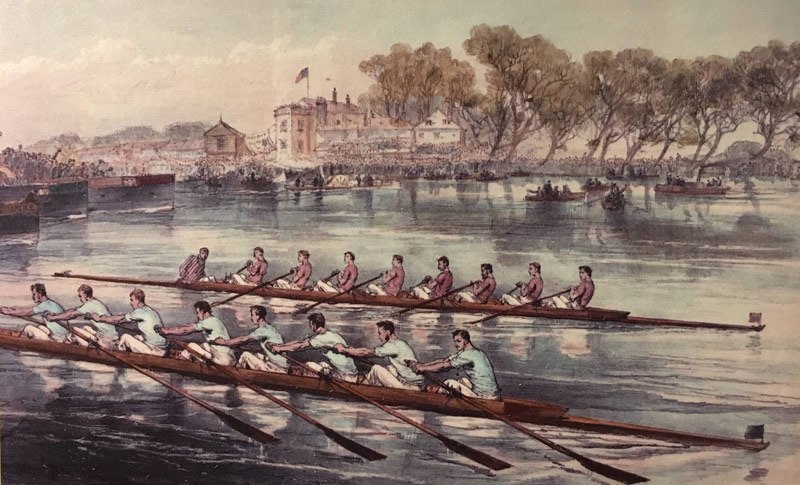I threw a picnic in our garden the other day. We were busy with all…
The Boat Race
Rowing is certainly one of the most British sports. I must admit, rowing always reminds me of the intro of the Persuaders (a 1970s TV Series) where on one side the life of the British Brett Sinclair (starred by Roger Moore) was shown and the American Danny Wilde’s (Tony Curtis) on the other side. While the Briton was rowing on the Thames, the American played baseball. I think, I saw rowing on the Thames here for the first time.
The English call the open-weight eight rowing race between the Universities of Cambridge and Oxford simply “The Boat Race”. How and when did it all start? In this post we will have a look at the history of the famous annual boat race.
It all started from rivalry…
Rivalry between universities is not new and definitely did not start with the boat race. In fact, it goes back hundreds of years but in the 19th century it manifested in sport. However, the boat race was not the first sport in which the universities of Cambridge and Oxford competed against each other! It was cricket and the two universities played against each other in 1827 and the boat race was held two years later in 1829.
The idea of the boat race came from two friends who went to Harrow School in London together. Charles Wordsworth (nephew to the famous poet, William Wordsworth) studied later in Oxford, while his friend, Charles Merivale went to Cambridge.
Cambridge seemed to have one step ahead of Oxford as their Rowing Club was established one year before the first Boat Race (1828), whereas the rowing club of Oxford was established much later, in 1839 even though Oxford had internal rowing races already back in 1815.
Why did Cambridge challenge Oxford to a boat race in 1829?
Well, the answer is simple: there were heavy rains during the cricket game in 1827 and because of that the match was called a draw which annoyed Cambridge. Therefore, Cambridge suggested a boat race to be held at Easter, 1829 in London or close to London. Oxford accepted the invitation on 22nd March, however, they asked to delay the race saying the rowing season does not start in Oxford until June. 🙂 Cambridge agreed to delay the race and suggested 10th June, also moving the race to the picturesque town of Henley-on-Thames. Oxford did not respond instantly, they went to check out the area in Henley instead – a typical English thing, I must add.

The first Boat Race
The first race took place on 10th June 1829 in Henley-on-Thames. Oxford attended the race wearing dark blue attire – colour of Christ Church. (Incidentally – the Thames is called Isis in Oxford and the word Thames means dark.) The race started at Hambleden Lock and finished in Henley. The course was ideal as this is the only naturally straight distance on the Thames which is long enough (1.6km) for a rowing race. On which side of the Thames the teams should row was decided with a toss. Oxford chose the Berkshire side – Cambridge would have chosen that, too. Oxford won the race which attracted a huge crowd: allegedly there were 20.000 people in Henley on that day, whilst Oxford was completely empty.
The second Boat Race and the rest
The second race was held a few years later in 1836 and the location was changed to race from Westminster to Putney. This was the first time Cambridge wore the light blue colour, a colour that probably was inspired by the Eton Blue as many of the Cambridge crew were from Eton. This time Cambridge won and another three in a row.
In 1842 Cambridge’s success broke when Oxford won the race which was moved to Henley again. It was an incredible win by Oxford: on the day of the race one of the crew fell ill and according to the rules no substitutes are accepted. So Oxford started the race with 7 oarsmen only, dropping the idea of winning the race. Yet they did it and won in the end. The celebrations were mad.
The boat race has been an annual event since 1856, however, the race did not take place during the First and Second World War. According to the tradition, the loser of the race challenges the winner to a rematch every year.

Interesting facts:
Markers
The official start and finish lines are marked by stones on the south bank of the Thames. These have ‘UBR’ on them for University Boat Race.
The famous dead heat
According to the legend, the judge, Honest John Phelps was asleep under a bush when the race ended, therefore, he announced that the result was a dead heat. 🙂 The reality was, his view was obscured by the boats around the finish line and could not see the winner properly.
Sinking
In 1978, Cambridge completely sank after strong winds filled their boat with water just before the finishing line, leaving Oxford to pass the stranded team and win the race.
Famous members
Hugh Laurie was an oarsman in 1980 rowing for Cambridge and Lord Snowdon (British photographer and film maker) was a cox in 1950 for the same team.
Funniest commentator
The most famous commentary on The Boat Race was by the BBC radio commentator John Snagge in 1949, who reported: “I can’t see who’s in the lead but it’s either Oxford or Cambridge.”
Length of the boat
The length of an open-weight eight boat is 18.9m.
Balance
Nr of wins: Cambridge 44 vs Oxford 30
Sport antiques
Original prints from the 19th century and beginning of the 20th century as well as old oars and keels (antique sport memorabilia) are extremely expensive. An original 1863 university boat race Oar would cost £3200!




Comments (0)